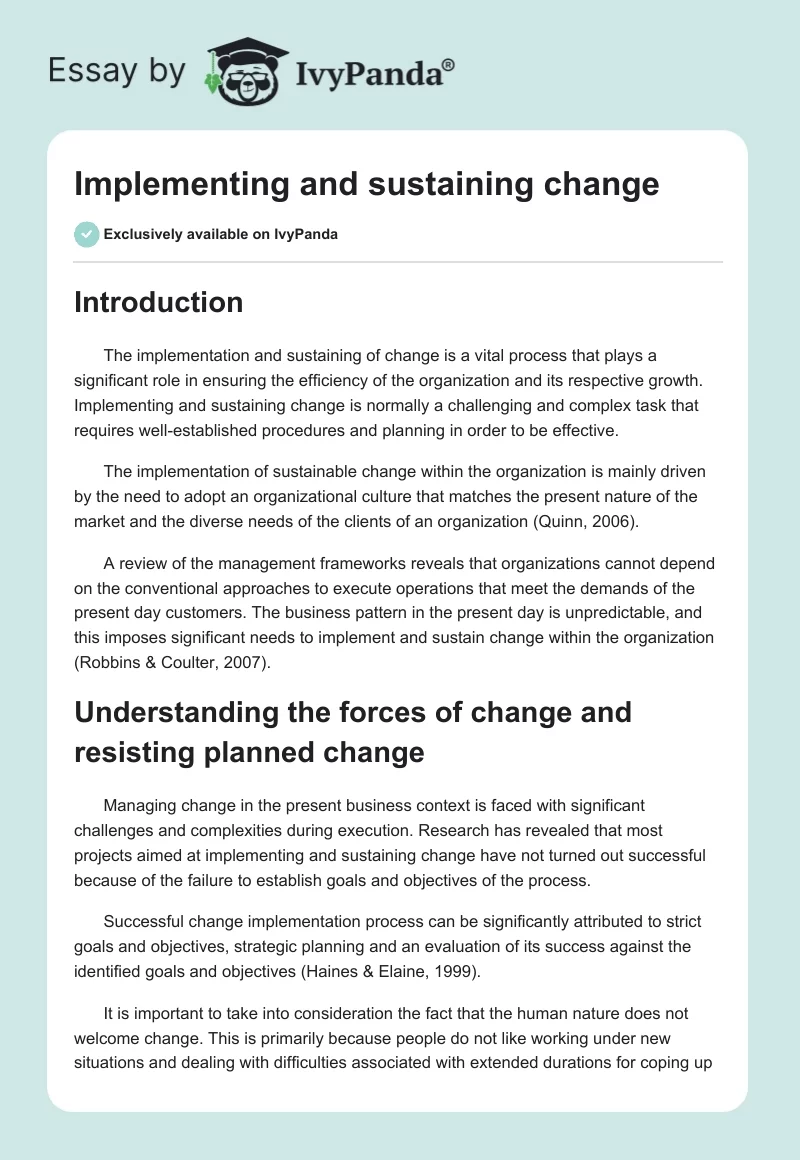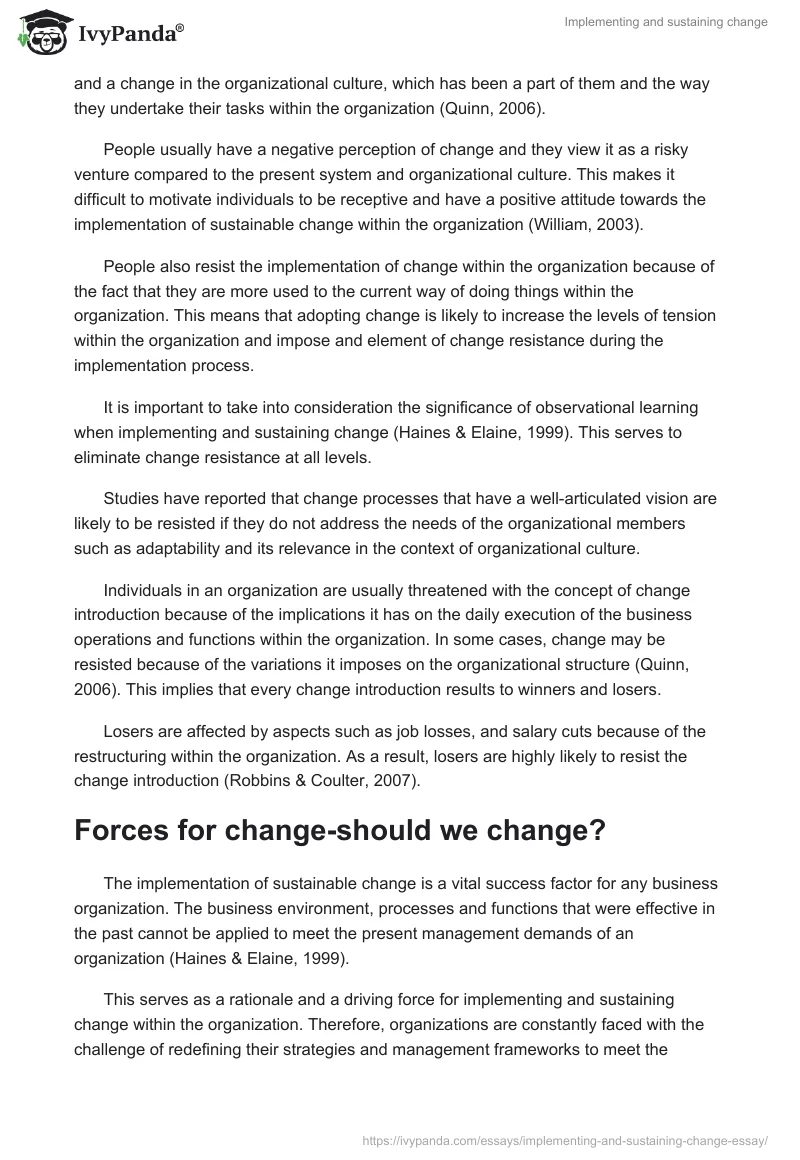Introduction
The implementation and sustaining of change is a vital process that plays a significant role in ensuring the efficiency of the organization and its respective growth. Implementing and sustaining change is normally a challenging and complex task that requires well-established procedures and planning in order to be effective.
The implementation of sustainable change within the organization is mainly driven by the need to adopt an organizational culture that matches the present nature of the market and the diverse needs of the clients of an organization (Quinn, 2006).
A review of the management frameworks reveals that organizations cannot depend on the conventional approaches to execute operations that meet the demands of the present day customers. The business pattern in the present day is unpredictable, and this imposes significant needs to implement and sustain change within the organization (Robbins & Coulter, 2007).
Understanding the forces of change and resisting planned change
Managing change in the present business context is faced with significant challenges and complexities during execution. Research has revealed that most projects aimed at implementing and sustaining change have not turned out successful because of the failure to establish goals and objectives of the process.
Successful change implementation process can be significantly attributed to strict goals and objectives, strategic planning and an evaluation of its success against the identified goals and objectives (Haines & Elaine, 1999).
It is important to take into consideration the fact that the human nature does not welcome change. This is primarily because people do not like working under new situations and dealing with difficulties associated with extended durations for coping up and a change in the organizational culture, which has been a part of them and the way they undertake their tasks within the organization (Quinn, 2006).
People usually have a negative perception of change and they view it as a risky venture compared to the present system and organizational culture. This makes it difficult to motivate individuals to be receptive and have a positive attitude towards the implementation of sustainable change within the organization (William, 2003).
People also resist the implementation of change within the organization because of the fact that they are more used to the current way of doing things within the organization. This means that adopting change is likely to increase the levels of tension within the organization and impose and element of change resistance during the implementation process.
It is important to take into consideration the significance of observational learning when implementing and sustaining change (Haines & Elaine, 1999). This serves to eliminate change resistance at all levels.
Studies have reported that change processes that have a well-articulated vision are likely to be resisted if they do not address the needs of the organizational members such as adaptability and its relevance in the context of organizational culture.
Individuals in an organization are usually threatened with the concept of change introduction because of the implications it has on the daily execution of the business operations and functions within the organization. In some cases, change may be resisted because of the variations it imposes on the organizational structure (Quinn, 2006). This implies that every change introduction results to winners and losers.
Losers are affected by aspects such as job losses, and salary cuts because of the restructuring within the organization. As a result, losers are highly likely to resist the change introduction (Robbins & Coulter, 2007).
Forces for change-should we change?
The implementation of sustainable change is a vital success factor for any business organization. The business environment, processes and functions that were effective in the past cannot be applied to meet the present management demands of an organization (Haines & Elaine, 1999).
This serves as a rationale and a driving force for implementing and sustaining change within the organization. Therefore, organizations are constantly faced with the challenge of redefining their strategies and management frameworks to meet the present business requirements and function effectively in a dynamic business environment (IBM, 2009).
Resistance to change- can we change?
In order to address the challenges and complexities of implementing and sustaining change, there is need to adopt effective change strategies. Implementing and sustaining change is possible provided the appropriate methodology is put in place to address the challenges of change management. Leadership change is one of the most effective strategies that can be used to facilitate change introduction.
Leadership change involves the establishment of an organizational culture that is receptive towards change. It is vital to take into account the significance of the organizational culture in enhancing the performance of the organization (William, 2003).
Therefore, the strategy for implementing and sustaining change should put more emphasis on the establishment of a strong organizational culture, which is helpful in facilitating the execution of the business operations and management of business functions (Quinn, 2006). It is very important that the organizational change approach should not augment the realization of existing value but also embark on future growth.
This is attainable using effectual change management and program plan. When implementing and sustaining change, it is important to take into account the aspect of organizational design in order to enhance the streamlining of the organizational processes with its respective structure (Haines & Elaine, 1999).
The involvement of the stakeholders is also a significant requirement for effective change methodology. Stakeholder involvement is attainable using effective communication channels with the major organizational stakeholders with the principal objective of enhancing their commitment towards the implementation of sustainable change (Robbins & Coulter, 2007).
Culture transformation is also vital in making change a success. This is because it translates to increased levels of employee productivity, which makes significant contributions to the success of the organization (Robbins & Coulter, 2007).
Designing change
Prior to implementing sustainable change, a critical analysis of the efficiency of the current system is needed in order to determine whether the change is justified. After a decision to adopt change within the organization has been reached, it is important to outline the vision for change (IBM, 2009). This is helpful in avoiding instances associated with deviation from the established goals and objectives.
The vision for change should specify the business goals and objectives and the core business processes that influence the success of the organization. Sharing the vision for change serves to enhance the level of organizational commitment towards the change. This includes the top executives and the employees of the organization (IBM, 2009).
The design of change should be based on a gradual methodology. Speedy and static organizational changes usually faces significant resistance from the employees and do not offer adequate time for adjustment.
Steady changes in the organization provide a prospect through which organizational members can become accustomed to the new system, while simultaneously keeping them involved with the previous system and culture. Gradual organizational change is attainable using change procedures that provider facilitation and necessary support to sustain the change (Robbins & Coulter, 2007).
References
Haines, S., 2004. ABCs of strategic management : an executive briefing and plan-to plan day on strategic management in the 21st century. New York: Cengage Learning.
IBM, 2009. IBM Global Study: Majority of Organisational Change Projects Fail. Web.
Quinn, R., 2006. Becoming a master manager: a competing values approach. New York: Wiley.
Robbins, S. & Coulter, M., 2007. Management. New Jersey: Pearson Prentice Hall.
William, B., 2003. Managing Transitions: Making the Most of Change. New York: Cambrige.


